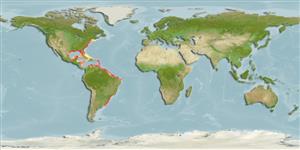>
Eupercaria/misc (Various families in series Eupercaria) >
Sciaenidae (Drums or croakers)
Etymology: Micropogonias: Greek, mikros = small + greek, pogon = beard (Ref. 45335).
More on author: Linnaeus.
Environment: milieu / climate zone / depth range / distribution range
Ökologie
seewasser; brackwasser demersal; tiefenbereich ? - 100 m. Subtropical; 43°N - 37°S
Western Atlantic: Massachusetts, USA (excluding Florida) and northern Gulf of Mexico to northern Mexico. Possibly from southern Brazil to Argentina. Uncertain in southern Gulf of Mexico, Lesser Antilles and southern Caribbean (Ref. 26938).
Length at first maturity / Size / Gewicht / Alter
Maturity: Lm ?, range 18 - ? cm
Max length : 55.0 cm TL Männchen/unbestimmt; (Ref. 40637); common length : 30.0 cm TL Männchen/unbestimmt; (Ref. 3702); max. veröff. Gewicht: 2.6 kg (Ref. 40637); max. veröff. Alter: 5 Jahre (Ref. 12193)
Adults occur usually over mud and sandy mud bottoms in coastal waters and in estuaries where the nursery and feeding grounds are located. They feed mainly on worms, crustaceans and fishes. An excellent foodfish. Sold fresh and frozen; eaten fried, broiled, microwaved and baked (Ref. 9988).
Life cycle and mating behavior
Geschlechtsreife | Fortpflanzung | Ablaichen | Eier | Fecundity | Larven
Robins, C.R. and G.C. Ray, 1986. A field guide to Atlantic coast fishes of North America. Houghton Mifflin Company, Boston, U.S.A. 354 p. (Ref. 7251)
IUCN Rote Liste Status (Ref. 130435)
Bedrohung für Menschen
Harmless
Nutzung durch Menschen
Fischereien: kommerziell; Aquakultur: experimental; Sportfisch: ja
Tools
Zusatzinformationen
Download XML
Internet Quellen
Estimates based on models
Preferred temperature (Ref.
123201): 14.2 - 27.7, mean 24.1 °C (based on 540 cells).
Phylogenetic diversity index (Ref.
82804): PD
50 = 0.5156 [Uniqueness, from 0.5 = low to 2.0 = high].
Bayesian length-weight: a=0.00851 (0.00774 - 0.00936), b=3.09 (3.06 - 3.12), in cm total length, based on LWR estimates for this species (Ref.
93245).
Trophic level (Ref.
69278): 4.0 ±0.50 se; based on food items.
Widerstandsfähigkeit (Ref.
120179): mittel, Verdopplung der Population dauert 1,4 - 4,4 Jahre. (K=0.2-0.27; tm=1-2; tmax=5).
Fishing Vulnerability (Ref.
59153): Low to moderate vulnerability (34 of 100).
Climate Vulnerability (Ref.
125649): High to very high vulnerability (66 of 100).
Nutrients (Ref.
124155): Calcium = 74.3 [40.8, 145.2] mg/100g; Iron = 1.07 [0.56, 1.87] mg/100g; Protein = 20.1 [18.4, 21.7] %; Omega3 = 0.303 [0.149, 0.596] g/100g; Selenium = 26.2 [13.9, 50.6] μg/100g; VitaminA = 16.4 [5.7, 55.5] μg/100g; Zinc = 0.688 [0.492, 1.006] mg/100g (wet weight);
